ANIMAL’S PLANET (show 5) – TRT: 23.32
The human animal modifies its living environment.
[toggle title=”ICELAND; Fabienne Gautier; TRT: 4.19
Landscapes of starkness speak to the internal mind.
Read more…” status=”progression_closed”]

Iceland’s landscape seemed to reflect a particular internalization of feeling. The piece was shot in B&W super 8 while driving across Iceland in 2004. This work speaks to this internal mind.
Q: How did this film come about?
I had wanted to make a film which expressed the abandonment of nature place since my other films are urban and deal with the alienation in cities. The genesis of the idea for ‘Iceland’ comes from the stark landscapes and almost deserted roads. I feel these outlands are a more eloquent statement.
Q: Why Iceland?
Inherent in the landscape of Iceland I found the starkness and emptiness quite simple and profoundly shocking if not ‘scary’ in its extremes. I had been searching for this. At the same time Iceland’s landscape reveal its own poetry.
Q: How did you choose the soundtrack?
The soundtrack for Iceland is a composition which I created using captured sounds. I regularly record sounds using diverse devices.
I wanted something which underlines the rhythm of the road and gives a feeling of meditation. In my imagination, the stones and the land create a dialogue. My interpretation of Iceland’s mystical landscapes allow an atmosphere of interaction and communication. I use the sound like breathing, to give an underlying theme to my film. The split screen is a counterpoint.
Q: Why do split screen for this film?
My original idea was to create a double screen installation. I changed my mind once confronted with the wilderness. I chose the split screen because the subject is always the same but may seem different from one point of view to the other. The landscape is in constant movement. Iceland is like a journey which never ends, a passage from one stage or experience to another.
[/toggle]
[toggle title=”AND THIS FOREST WILL BE A DESERT; C&A Projects (Carolyn Radlo & Alanna Simone); music by Wardruna; TRT: 2.33
Glittering plastic, toy polar bear and the beauty inherent in the things we’re conditioned to be afraid of.
Read more…” status=”progression_closed”]
An art film about the state of the world: it’s all about plastics, panic and paradise.
A translucent landscape, a sparkling pile of trash, is inhabited by a wry polar bear. Rapid text appears over the images – condensed versions of three different mythologies, three different fires: the battles of Ragnarök, the Nordic end of the world; an account of a recent forest fire caused by changing weather patterns; and Muhammad’s ascent to the highest fiery heaven. Each layer reiterates the background source of our worried fantasies and fears of destruction despite the beauty to be found right here, right now.
The film features awe-inspiring music by Nordic-roots band, Wardruna.
And This Forest Will be a Desert developed organically out of a fascination with plastic, spontaneously after the gift of a toy polar bear, and thoughtfully in response to world events and inflamed news reportage about massive forest fires, suicide bombings, acts of violence and destruction.
Q: You two worked together on this film, how did that come about?
C: I’ve known Alanna for a really long time! [laughs]
A: We’ve been working together on collaborative video projects for just over ten years. Our first project together started while I was still in film school. I was so eager to work on an art project—something so different from all the Hollywood-infused work I was surrounded by. We learned how to work together as we went along.
C: Yeah, unlike feature films, our artworks aren’t scheduled and composed beforehand. Linearity is not the point. But the technical know-how you bring to our projects is so valuable, but you had to adjust to my amorphous approach!
A: Our work reflects our relationship to each other. There are so many layers, starting from being mother and daughter, we are friends and confidants, we engage together with ideas—politics, mythology, psychology, history—so much of our lives are intertwined that it was a natural evolution to do creative work together.
C: We are like a Venn Diagram—we are both artists interested in many of the same things but with different inflections and different strengths.
A: Yes! You can read poetry!
Q: What was your creative process to make this film?
A: We were participating in Papergirl Berlin—we spent an afternoon walking around San Francisco with a little plastic polar bear toy, taking photographs of it in different contexts—
C: —like in a bar where the polar bear dove into an icy cocktail!
A: Right, then later we paired two images with small excerpts of text from two different articles, both first person accounts, one of a devastating forest fire in the Rockies and the other about an archaeological site where it appeared that the people had used up all of their natural resources until the city was no longer viable.
C: It looked like fun to be working with this plastic bear—people even commented about that when they saw us on the street—but actually it was serious. The polar bear is the poster child for global warming and this was a plastic bear.
A: We’d also been collecting up the plastics from our daily lives—wrappings from a florist, packaging from crackers, water bottles and so on. We made a landscape of crinkled, translucent material and then there was that little polar bear. Everything was shot as stills and combined in post.
Then the three texts came together. (The Norse story of the battle of Ragnarök, that same description of the forest fire and Muhammad’s ascent to Firdaus, the uppermost level of heaven.) It was hard to escape the irony of the plastic landscape and the plastic polar bear with their implications about climate change and fossil fuel use. We had been discussing all the different ideas of apocalypse, the final battle which allows for a new world order.
C: The end of times. Environmental disaster. Behind it all are ideations, mythologies of sin and retribution, the gods destroying creation, and death, of course.
A: We were interested in the idea that no matter what happens to the infestation of humans, our planet will go on evolving and the atmosphere will heat up or cool off and either way something different will take our collective place. And then there was always so much beauty to be found in the sparkling, mutable pile of plastics.
C: The sunlight streaming through the glassine material sparkles and makes rainbows. And even as I say that, I am reminded that in the bible, the rainbow is the symbol Yahweh gives as promise never to destroy the world by flood again (but he reserves the right to fire!)
A: Following a convoluted chain of impulses, Carolyn discovered that one of the musicians in this Norwegian Black Metal band (Gaahl, the singer of Gorgoroth) had a side project called Wardruna, founded by Einar “Kvitrafn” Selvik who was building and playing traditional Nordic instruments. The music is amazing, and Einar was gracious enough to allow us to use two songs from their first album.
C: The music is awesome and really gives dramatic punch to the film, it’s a perfect soundscape for the notions the film is all about.
A: We always seem to work with text. We wanted to do something graphically interesting with the words on the screen and I experimented with how fast text could appear while still being legible.
C: and it is just barely—which is the point! These apocalyptic ideas are hovering just under consciousness—in individuals, in the culture. But we are driven by these ideas!
[/toggle]
[toggle title=”CONSTELLATION; Muriel Montini; TRT: 5.00
A bear in the zoo. A bear out of the world.
Read more…” status=”progression_closed”]
Muriel Montini studied cinema. She lives and works in Paris. Since 2000, she has made several movies screened in different international important institutions and festivals. She currently works on different films projects.
[/toggle]
[toggle title=”THE STORY OF THE OCTOPUS WITH A HEARTSHAPED HEAD; Alessandra Cianelli; TRT: 11.40
Once upon a time there was a heart beating, that threw itself into the sea…
Read more…” status=”progression_closed”]
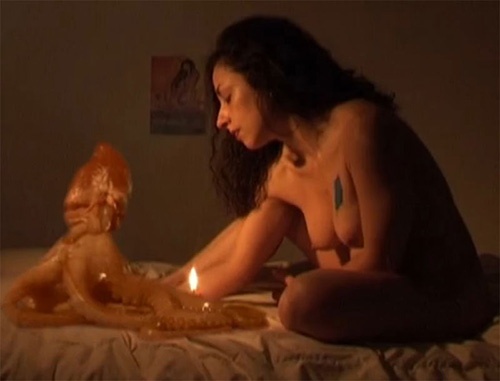
Through broad visionary material, The Story of the Octopus with a Heart-Shaped Head is actually a fairy tale, showing an existentialist experience carrying an autobiographical character and is also an anthropological investigation evolving specific ‘signs’ from the culture of Naples.
The illusionary attempt to get control of oneself and of the world is shown in this fairy-tale: through the total elimination and/or the substitution of the deep innermost dark sides of oneself. I think that it is up to every human being to come to terms with one’s own “monster of the abyss”, which is composed of all that we are, we have been, we wish to be, on an individual level; and as part of coming to terms with the esseri umani and parte della collettività (human beings and part of the community) – trying to avoid the temptation to hide and relegate “the monster” into the shadows.
The analogy of “octopus/heart” was initially an unconscious association and only in a subsequent phase it found its scientific bases.
The octopus moves itself with what we call the head, but in fact it is actually the abdomen which functions like a pump, an hydrojet, aspiring and expelling water: this is the way the heart functions. Thus a common imagery is attained: the heart represents the nucleus of emotions and feelings, and also symbolizes the perpetual changes of emotional life.
The Heart, in quest of an identity and in order to survive, throws itself into the sea, the water that is the most similar to the liquid of the placenta. The Heart couples himself with an Octopus by substituting what we would call the “head,” which is actually the stomach.
The beating of a sane heart is chaotic. The head is the center of rationality and of the cold and immobile mind. The stomach is the focal point for the instincts and for the primary willingness to live…
Regarding the sound tracks: Adriano Casale/Bk Bostike composed this original soundtrack by starting with the song “Death and the Maiden” composed by Franz Schubert in 1817 and from the ‘sound’ of the sea water. I filmed in my studio and on Palazzo Donn’Anna beach, which is a place dominated by a fascinating antique palace dating back to the sixteenth century. I have also used some footage from the the Zoological Mariner Station Dorhrn Aquarium in Naples.
[/toggle]

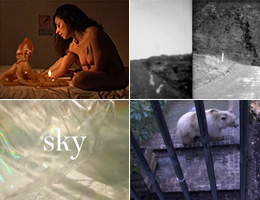
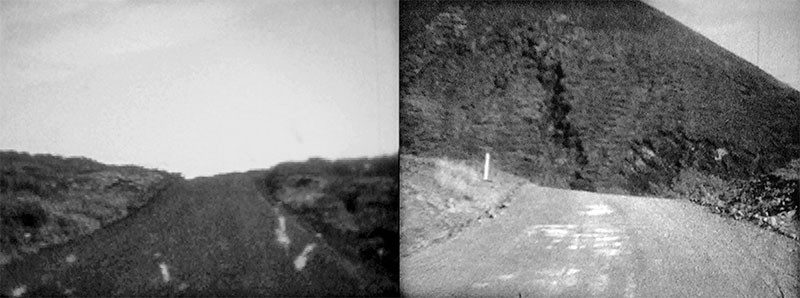




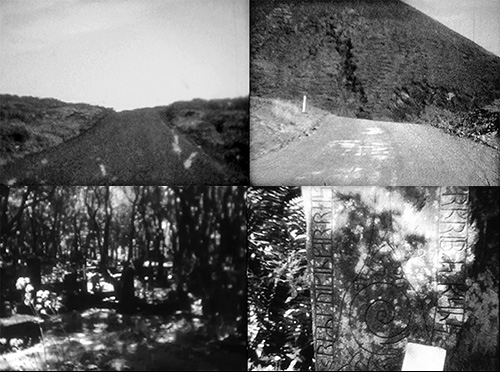
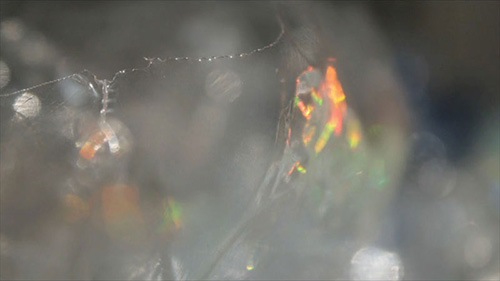
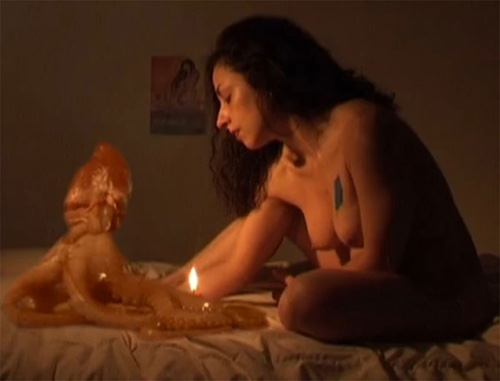



Very nice flow from one to the next, thanks for having a site like this!